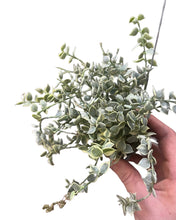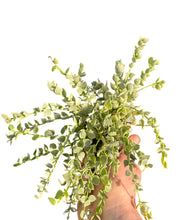Dischidia ruscifolia is part of the Apocynaceae family and its native range is the Philippines. It is described as a climbing subshrub and grows primarily in the wet tropical biome.This epiphyte will grow well in a hanging planter but if you gave it sphagnum or cork bark to climb on, it would use the adventitious roots it produces at the node to attach itself on the substrate. In their native environment Dischidia would form dense masses as they climb and creep along tree surfaces and they thrive in higher humidity.
Dischida ruscifolia has a compact growth habit, leaves are ovate in shape with an acuminate apex and a rounded leaf base. Leaves are opposite and decussate in arrangement and are known to sunstress to a pink-red colour. Blooms are small and bell-shaped with petals that open to form a star shape, they are creamy-white colour.
Genus name comes from the Greek ‘dis’ meaning twice and the Latin ‘schidius’ meaning cleft or split. The specific epithet is from the Latin 'Ruscus', a shrub and 'folium' meaning leaf; Dischidia with Ruscus-like leaves in reference to the apex of the leaf terminating in a stiff point.
This plant is potted in a coco husk plug. We do not recommend removing the plant from the coco husk plug for at least 8 weeks.
Pot: ø 7cm.
Foliage: Approximately 15cm in length.
Light: Dischidia grow in filtered sunlight in their native environment, in the home I would recommend an east or both-east facing window; this species will turn red if it’s getting lots of light. It is important for the plant to see the sky in order to thrive and to metabolise the water we give them.
Water: If your Dischidia is in a well draining mix or mounted, you will need to water more frequently than if it is in a dense potting mix. They can dry out a little as they are very drought tolerant.
Potting mix: A chunky well draining mix composed of a small amount of coco coir, perlite or vermiculite, orchid bark and worm castings; you could also add some horticultural charcoal to this epiphytic mix. You can also grow this plant in coco coir chips or mounted with sphagnum moss. Dischidia require excellent drainage and are used to good air circulation around their roots.
Fertilising: They’re not heavy feeders but you can feed your plant every few waterings during the growing season or when you observe active growth. You can dilute fertiliser to half the recommended amount but never add more.
Temperature: Day temperatures 12-30°C. Night temperature 12-18°C. General range 18-30˚C.
Humidity: Dischidia would prefer higher humidity, between 60-80% but do well to adjust to average home humidity. You can increase humidity by placing the plant on a watered pebble tray or using a humidifier.
Dischidia aren’t considered toxic, however, they may make your pet or child vomit if ingested, keep out of reach just to be safe.



